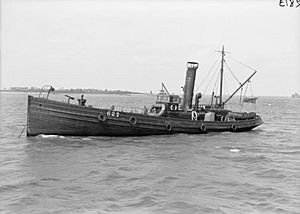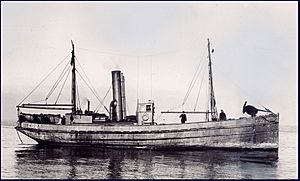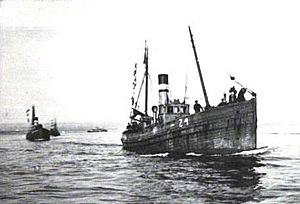Naval drifter facts for kids
A naval drifter was a type of boat used by navies, especially during wartime. It was built like a regular fishing boat called a "drifter," but it was equipped for military jobs. Navies also used similar boats called naval trawlers.
Fishing trawlers were designed to pull heavy fishing nets, so they could easily be changed to pull minesweepers (devices that clear underwater mines). Drifters were strong boats, built to work in almost any weather. They were made to put out and pull in "drift nets," which are long fishing nets that float.
Naval drifters were usually smaller and slower than trawlers. When navies took them over, they often added an anti-submarine gun and depth charges (bombs that explode underwater). These boats were then used to set up and patrol anti-submarine nets, which helped protect ships from enemy submarines.

During World War I, the Royal Navy (Britain's navy) needed many ships quickly. They took over many fishing drifters and changed them for naval use.
The British Admiralty (the part of the government that managed the navy) also ordered 362 new naval drifters to be built. These were called "Admiralty drifters." Shipyards that usually built fishing boats could easily switch to making these naval versions. A good thing about these boats was that after the war, they could be sold to people who wanted to use them for fishing.
There were two main types of Admiralty-built drifters:
- Wooden-hulled drifters: These boats weighed about 175 tons and were 26.2 meters (86 feet) long. They could travel at 9 knots (about 17 kilometers per hour) and carried one 6-pounder gun. About 91 of these were launched between 1918 and 1920. Canada also ordered 100 similar boats in 1917.
- Steel-hulled drifters: These were slightly heavier at 199 tons and were also 26.2 meters (86 feet) long. They had a speed of 9 knots and carried the same type of gun. About 123 steel-hulled drifters were launched between 1917 and 1920.
Most Royal Navy drifters were given names, just like trawlers. However, the drifters built in Canada were simply numbered from CD 1 to CD 100.
The Battle of the Strait of Otranto
In 1917, a group of British drifters, protected by destroyers and light cruisers, created a blockade across the Strait of Otranto. This strait is 72 kilometers (45 miles) wide and connects the Adriatic Sea to the Mediterranean Sea. The blockade stopped the Austro-Hungarian Navy from entering the Mediterranean.
On May 15, 1917, the Austro-Hungarian Navy attacked this blockade. Before opening fire, they usually warned the drifter crews to leave their boats. However, some drifter crews decided to fight back. The drifter Gowan Lee fired at the Austro-Hungarian ships. The Gowan Lee was badly damaged but stayed afloat.
The captain of the Gowan Lee, named Joseph Watt, was later given the Victoria Cross (a very brave award) for his actions during the battle. Out of 47 drifters in the blockade that day, 14 were sunk and 4 were damaged. Because there were not enough Allied escort ships, the remaining drifters had to pull back, but only for a short time.
See also



